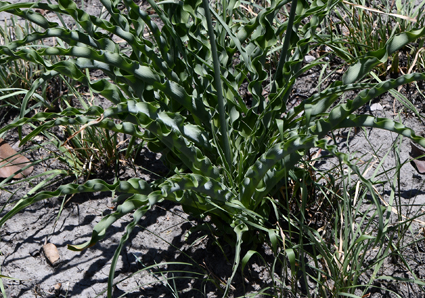Abstract
Molecular, morphological and chromosome research have identified several subgroups in Chlorophytum. One of the subgroups has been referred to as “The paniculate spongy-rooted group”, where the delimitation of several species have been questioned. To determine if this is a natural group and to clarify taxonomic boundaries between species, molecular phylogenetic analyses were performed based on ITS, rps16 intron, trnL intron, trnL‑F spacer, psbA-trnH spacer, and rps12-rpl20 spacer. Chlorophytum hirsutum, hypothesized to be sister to C. andongense, did not resolve within “The paniculate spongy-rooted group”. A closer examination of the roots of C. hirsutum showed they were different from roots of the other members of this group. Two species, C. andongense and C. macrosporum, have been suggested to be conspecific, however, this study found that the taxa were genetically and morphologically distinct. The analyses further revealed considerable genetic variation in the geographically widespread species C. andongense, something that should be studied further.
References
- Baker, J.G. (1876) Revision of the genera and species Anthericeae and Eriospermeae. Journal of the Linnean Society, Botany 15: 253–363. https://doi.org/10.1111/j.1095-8339.1876.tb00247.x
- Baker, J.G. (1878) Report on the Liliaceae, Iridaceae, Hypoxidaceae, and Haemodoraceae of Welwitch`s Angolean Herbarium. Transactions of the Linnean Society of London, Botany 1: 245–273. https://doi.org/10.1111/j.1095-8339.1878.tb00040.x
- Baker, J.G. (1898) Anthericum. Flora of Tropical Africa 7 (3): 477–493.
- Bjorå, C.S. (2008) Phylogeny, speciation and biogeography—a study of Crinum and Chlorophytum (Asparagales) with focus on Africa taxa. PhD thesis, University of Oslo, Oslo.
- Bjorå, C.S., Elden, M., Nordal, I., Brysting, A.K., Awas, T., Demissew, S. & Bendiksby, M. (2017) Speciation in the genera Anthericum and Chlorophytum (Asparagaceae) in Ethiopia—a molecular phylogenetic approach. Phytotaxa 297 (2): 139–156. https://doi.org/10.11646/phytotaxa.297.2.2
- Bjorå, C.S., Hoell, G., Kativu, S. & Nordal, I. (2008) New taxa of Chlorophytum (Anthericaceae) from Southern Tropical Africa with notes on their sister group relationships. Botanical Journal of the Linnean Society 157: 223–238. https://doi.org/10.1111/j.1095-8339.2008.00811.x
- Darriba, D., Taboada, G.L., Doallo, R. & Posada, D. (2012) jModelTest 2: more models, new heuristics and parallel computing. Nature Methods 9 (8): 772. https://doi.org/10.1038/nmeth.2109
- Edgar, R.C. (2004) MUSCLE: multiple sequence alignment with high accuracy and high throughout, Nucleic Acids Research 32 (5): 1792–1797. https://doi.org/10.1093/nar/gkh340
- Engler, H.G.A. (1895) Fam. Liliaceae, Die Pflanzenwelt Ost-Afrikas und der Nachbargebiete. Teil C. Verlag G. Reimer, Berlin, 141 pp. https://doi.org/10.5962/bhl.title.587
- Farris, J.S., Albert, V.A., Källersjö, M., Lipscomb, D. & Kluge, A.G. (1996) Parsimony jackknifing outperforms neighbor joining. Cladistics 12 (2): 99–124. https://doi.org/10.1006/clad.1996.0008
- GBIF.org. (2020) GBIF Home Page. Available from: http://www.gbif.org (accessed 10 June 2020)
- Goloboff, P.A., Farris, J.S. & Nixon, K.C. (2008) TNT, a free program for phylogenetic analysis. Cladistics - International Journal of the Willi Hennig Society 24: 774–786. https://doi.org/10.1111/j.1096-0031.2008.00217.x
- Guindon, S. & Gascuel, O. (2003) A simple, fast and accurate method to estimate large phylogenies by maximum-likelihood. Systematic Biology 52: 696–704. https://doi.org/10.1080/10635150390235520
- Hall, T.A. (1999) BioEdit: a user-friendly biological sequence alignment editor and analysis program for Windows 95/98/NT. Nucleic Acids Symposium Series 41: 95–98
- Hamilton, M.B. (1999) Four primer pairs for the amplification of chloroplast intergenic regions with intraspecific variation. Molecular Ecology 8 (3): 521–523.
- Hoell, G. (2005) The genera Anthericum and Chlorophytum (Anthericaceae), evolution and delimitation. Cand. Scient. thesis, Faculty of Mathematics and Natural Sciences, University of Oslo, 73 pp.
- Huelsenbeck, J.P. & Ronquist, F. (2001) MRBAYES: Bayesian inference of phylogenetic trees. Bioinformatics 17 (8): 754–755. https://doi.org/10.1093/bioinformatics/17.8.754
- Kativu, S., Hoell, G., Bjorå, C.S. & Nordal, I. (2008) Anthericaceae. In: Timberlake, J.R. & Martins, E.S (Eds.) Flora zambesiaca. Vol. 13 (1). Kew, Royal Botanic Gardens. pp. 34–89.
- Kearse, M., Moir, R., Wilson, A., Stones-Havas, S., Cheung, M., Sturrock, S., Buxton, S., Cooper, A., Markowitz, S., Duran, C., Thierer, T., Ashton, B., Meintjes, P. & Drummond, A. (2012) Geneious Basic: An integrated and extendable desktop software platform for the organization and analysis of sequence data. Bioinformatics 28 (12): 1647–1649. https://doi.org/10.1093/bioinformatics/bts199
- Ker Gawler, J.B. (1807) Chlorophytum inornatum. Curtis’s Botanical Magazine 27: t. 1071.
- Linnaeus, C. (1753) Species Plantarum. Vol. 1. Laurentius Salvius, Stockholm, 560 pp.
- Meerts, P. & Bjorå, C.S. (2012) Synopsis of the genus Chlorophytum (Asparagaceae) in Central Africa (Democratic Republic of the Congo, Rwanda, Burundi). Plant Ecology and Evolution 145 (3): 373–409. https://doi.org/10.5091/plecevo.2012.668
- Nordal, I. (1997) Anthericaceae. In: Edwards, S., Sebsebe, Demissew, S. & Hedberg, I. (Eds.) Flora of Ethiopia and Eritrea. Vol. 6. Addis Ababa and Uppsala. pp. 90–105.
- Nordal, I., Kativu, S. & Poulsen, A.D. (1997) Anthericaceae. In: Polhill, R.M. (Ed.) Flora of Tropical East Africa. A. A. Balkema, Rotterdam
- Oxelman, B., Lidén, M. & Berglund, D. (1997) Chloroplast rps-16 intron phylogeny of the tribe Sileneae (Caryophyllaceae). Plant Systematic and Evolution 206: 393–410. https://doi.org/10.1007/BF00987959
- Poellnitz, K.V. (1943) Zur Kenntnis der Gatung Chlorophytum Ker. Berichte der Deutschen Botanischen Gesellschaft 61: 126–131. https://doi.org/10.1111/j.1438-8677.1943.tb01740.x
- Poulsen, A.D. & Nordal, I. (1999) Two new species of Chlorophytum from central Africa. Kew Bulletin 54 (4): 941–949. https://doi.org/10.2307/4111172
- Ronquist, F. & Huelsenbeck, J.P. (2003) MRBAYES 3: Bayesian phylogenetic inference under mixed models. Bioinformatics 19 (12): 1572–1574. https://doi.org/10.1093/bioinformatics/btg180
- Schweinfurth, G. (1876) Revision of the genera and species Anthericeae and Eriospermeae. Journal of the Linnean Society, Botany 15: 253–363. https://doi.org/10.1111/j.1095-8339.1876.tb00247.x
- Simmons, M.P. & Ochoterena, H. (2000) Gaps as characters in sequence-based phylogenetic analyses. Systematic Biology 49: 369–381. https://doi.org/10.1093/sysbio/49.2.369
- Taberlet, P., Gielly, L., Pautou, G. & Bouvet, J. (1991) Universal primers for amplification of three non-coding regions of chloroplast DNA. Plant Molecular Biology 17: 1105–1109. https://doi.org/10.1007/BF00037152
- Tesfaye Awas & Nordal, I. (2007) Beninshangul Gumuz region in Ethiopia: A center of endemicity for Chlorophytum—with the description of C. pseudocaule sp. nov. (Anthericaceae). Kew Bulletin 62: 129–132.
- White, T.J., Bruns, T., Lee, S. & Taylor, J. (1990) Amplification and direct sequencing of fungal ribosomal RNA genes for phylogenetics. In: Innis, M.A., Gelfand, D.H., Sninski, J.J. & White, T.J. (Eds.) PCR-protocols: A guide to methods and applications. San Diego: Academic press. pp. 315–322. https://doi.org/10.1016/B978-0-12-372180-8.50042-1


